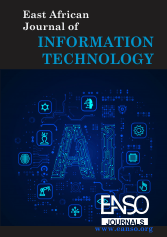Has Increased Digitisation of Services Led to More Cyber Exposure? A Desk Review
Abstract
The rapid process of digitisation of services has changed economies, altered social relationships and changed the governance processes across geographies. It has, however, exposed people, organisations, and governments to numerous cyber threats. This paper discusses the relationship between digitalisation of services and cyber exposure by the use of the desk review method. Using international reports and focusing on global, African and Kenyan research, the paper has been able to identify a similar pattern nationally and internationally: although digitisation contributes to efficiency, it also increases the number of chances to get hacked, particularly when the cybersecurity capacity is lower than expected. Cybercrime has been on the increase in Kenya, especially in the areas of finance and e-commerce, as well as government services. In conclusion, the paper will argue that to make digital transformation as sustainable, there is a need to mainstream cybersecurity in digital transformation policies
Downloads
References
Aguboshim, A. C., & Udokwu, F. C. (2020). Cybersecurity Threats in West Africa. African Journal of Security Studies, 8(1), 45–60.
Aldasoro, I., Gambacorta, L., Giudici, P., & Leach, T. (2022). The drivers of cyber risk. Journal of Financial Stability, 60, 100989.
Aon & World Economic Forum. (2023). Global Risks Report. Retrieved from https://www.weforum.org
Australian Cyber Security Centre. (2023). Annual Cyber Threat Report: July 2022 to June 2023.
Bada, A., & Sasse, M. A. (2015). Cybersecurity awareness campaigns: Why do they fail to change behaviour? arXiv preprint arXiv:1505.07676.
Bada, A., & Sasse, M. A. (2015). Cybersecurity awareness campaigns: Why do they fail to change behavior? arXiv preprint arXiv:1505.03873.
CAK. (2024). Cybersecurity Report Q4 2023. Communications Authority of Kenya.
CERT-IN. (2023). Cybersecurity Incidents Report 2022. Indian Computer Emergency Response Team.
Communications Authority of Kenya (CAK). (2018). Quarterly Sector Statistics Report: Q4 2018. Nairobi: CAK.
Communications Authority of Kenya (CAK). (2020). Quarterly Sector Statistics Report: Q4 2020. Nairobi: CAK.
Communications Authority of Kenya (CAK). (2024). Cybersecurity Statistics Report Q4 2023. Nairobi: CAK.
Communications Authority of Kenya. (2020–2024). Quarterly Sector Statistics Reports.
Cybersecurity Ventures. (2020). Cybercrime to Cost the World $10.5 Trillion Annually by 2025. Retrieved from https://cybersecurityventures.com
ENISA. (2022). Threat Landscape 2022. European Union Agency for Cybersecurity.
Estonian Information System Authority. (2023). Cybersecurity in Estonia: Annual Report.
FBI IC3. (2024). Internet Crime Report 2023. Federal Bureau of Investigation.
Forbes. (2024). Why Cybersecurity Breaches Are Increasing. Retrieved from https://www.forbes.com
Interpol. (2023). ASEAN Cyber Threat Assessment Report.
Jamilov, R., Rey, H., & Tahoun, A. (2021). The anatomy of cyber risk. National Bureau of Economic Research (No. w28906).
Kabaya, J., & Kageni, M. (2024). Cybersecurity preparedness in Kenya’s digital economy. African Journal of ICT Studies, 6(2), 87–95.
Kabaya, M., & Kageni, M. (2024). Cybersecurity in the wake of the fourth industrial revolution in Kenya.
Karanja, M. W., & Gatobu, P. (2024). IoT and cyber attacks among fintech companies in Kenya. IJSSME, 8(1).
Li, T., Zhang, Y., & Wu, M. (2022). Digital Transformation and Cyber Risks in China. Journal of Information Security, 11(4), 251–268.
Milani, M., d’Addona, D., & Teti, R. (2022). Individual cyber-victimization and behavioral patterns. Computers & Security, 112, 102541.
Milani, R., Caneppele, S., & Burkhardt, C. (2022). Exposure to cyber victimization: Results from a Swiss survey. Deviant Behavior, 43(2), 228-240.
Musau, D. (2024). Alarm as Kenya Records 860 Million Cyber Threats in Q4. Citizen Digital. Retrieved from https://citizen.digital
Mutuku, M. K., & Muathe, S. M. (2020). Nexus analysis: Internet of Things and business performance. International Journal of Research in Business and Social Science, 9(4), 175-181.
Mutune, E., Odongo, J., & Wamalwa, M. (2023). Cybersecurity Vulnerabilities in Kenya’s Mobile Money Ecosystem. Kenya Journal of Information Systems, 5(2), 33–49.
Mutune, J., Mwangi, M., & Maina, G. (2023). Vulnerability of Mobile Money Platforms in Kenya: A Cybersecurity Perspective. Journal of Digital Finance, 5(1), 22–35.
Mutune, M., Musumba, P., & Kiragu, S. (2023). Cyber fraud in mobile money in East Africa. African Journal of Information Security.
NCSC. (2023). Annual Review. UK National Cyber Security Centre.
Ndeda, L. A., & Odoyo, C. O. (2019). Cyber threats and cyber security in the Kenyan business context.
Obuhuma, J., & Zivuku, B. (2020). The State of Cybersecurity Preparedness in Kenyan Public Institutions. African Journal of Information Security, 5(2), 55–68.
PwC. (2024). Global Digital Trust Insights Survey. Retrieved from https://www.pwc.com
Radanliev, P. et al. (2018). Future developments in cyber risk assessment for the Internet of Things. Computers in Industry, 102, 14–22.
Radanliev, P., et al. (2018). Integration of cyber risk from the Internet of Things into cyber risk management. Journal of Risk Research, 21(6), 689–710.
Rutenberg, N., & Omariba, D. (2022). Data privacy and cybersecurity challenges in African healthcare systems. Health Policy and Technology, 11(1), 100594.
Serianu Ltd. (2014). Africa Cyber Security Report: Kenya 2014. Nairobi: Serianu.
Serianu Ltd. (2019). Africa Cyber Security Report: Kenya 2019. Nairobi: Serianu.
Sowon, K., et al. (2024). Privacy-Preserving Protocols for Mobile Money in Kenya. African Journal of FinTech Innovation, 4(1), 14–26.
TOO, W. K., & MUTUKU, M. (2023). An examination of the effects of cyber security in enhancing performance of the public sector institutions. Reviewed Journal International of Business Management [ISSN 2663-127X], 4(1), 471-477.
Turel, O., Qahri-Saremi, H., & Vaghefi, I. (2021). Dark sides of digitalization. International Journal of Electronic Commerce, 25(2), 127-135.
Waithaka, G. (2016). An Assessment of Cybersecurity Readiness in Kenya’s Public Sector. Journal of ICT Policy and Regulation, 3(1), 23–37.
Waithaka, S. W. (2016). Factors affecting cybersecurity in national government ministries in Kenya. (Doctoral dissertation, University of Nairobi).
Waliullah, M., Patel, K., & Singh, N. (2025). A Systematic Literature Review of Cybersecurity Threats in Digital Financial Services. International Journal of Information Security, 24(2), 113–138.
Wekundah, R. N. (2015). The effects of cybercrime on e-commerce; a model for SMEs in Kenya. (Doctoral dissertation, University of Nairobi).
World Economic Forum. (2023). The Global Risks Report 2023. Retrieved from https://www.weforum.org
Copyright (c) 2025 Morrisson Mutuku, PhD

This work is licensed under a Creative Commons Attribution 4.0 International License.




























